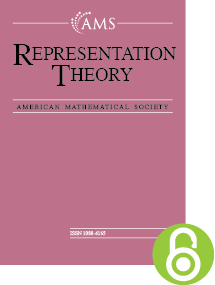Irreducible Genuine Characters of the Metaplectic Group: Kazhdan-Lusztig Algorithm and Vogan Duality
HTML articles powered by AMS MathViewer
- by David A. Renard and Peter E. Trapa
- Represent. Theory 4 (2000), 245-295
- DOI: https://doi.org/10.1090/S1088-4165-00-00105-9
- Published electronically: July 31, 2000
- PDF | Request permission
Abstract:
We establish a Kazhdan-Lusztig algorithm to compute characters of irreducible genuine representations of the (nonlinear) metaplectic group with half-integral infinitesimal character. We then prove a character multiplicity duality theorem for representations of $Mp(2n,\mathbb R)$ at fixed half-integral infinitesimal character. This allows us to extend some of Langlands’ ideas to $Mp(2n,\mathbb R)$.References
- Jeffrey Adams, Lifting of characters on orthogonal and metaplectic groups, Duke Math. J. 92 (1998), no. 1, 129–178. MR 1609329, DOI 10.1215/S0012-7094-98-09203-1
- Jeffrey Adams and Dan Barbasch, Genuine representations of the metaplectic group, Compositio Math. 113 (1998), no. 1, 23–66. MR 1638210, DOI 10.1023/A:1000450504919
- Jeffrey Adams, Dan Barbasch, and David A. Vogan Jr., The Langlands classification and irreducible characters for real reductive groups, Progress in Mathematics, vol. 104, Birkhäuser Boston, Inc., Boston, MA, 1992. MR 1162533, DOI 10.1007/978-1-4612-0383-4
- A. A. Beĭlinson, J. Bernstein, and P. Deligne, Faisceaux pervers, Analysis and topology on singular spaces, I (Luminy, 1981) Astérisque, vol. 100, Soc. Math. France, Paris, 1982, pp. 5–171 (French). MR 751966
- M. Goresky, R. Kottwitz, and R. MacPherson, Discrete series characters and the Lefschetz formula for Hecke operators, Duke Math. J. 89 (1997), no. 3, 477–554. MR 1470341, DOI 10.1215/S0012-7094-97-08922-5
- Rebecca A. Herb, Discrete series characters and two-structures, Trans. Amer. Math. Soc. 350 (1998), no. 8, 3341–3369. MR 1422607, DOI 10.1090/S0002-9947-98-01958-8
- R. P. Langlands, On the classification of irreducible representations of real algebraic groups, Representation theory and harmonic analysis on semisimple Lie groups, Math. Surveys Monogr., vol. 31, Amer. Math. Soc., Providence, RI, 1989, pp. 101–170. MR 1011897, DOI 10.1090/surv/031/03
- George Lusztig and David A. Vogan Jr., Singularities of closures of $K$-orbits on flag manifolds, Invent. Math. 71 (1983), no. 2, 365–379. MR 689649, DOI 10.1007/BF01389103
- J. G. M. Mars and T. A. Springer, Hecke algebra representations related to spherical varieties, Represent. Theory 2 (1998), 33–69. MR 1600804, DOI 10.1090/S1088-4165-98-00027-2
- Toshihiko Matsuki and Toshio Ōshima, Embeddings of discrete series into principal series, The orbit method in representation theory (Copenhagen, 1988) Progr. Math., vol. 82, Birkhäuser Boston, Boston, MA, 1990, pp. 147–175. MR 1095345, DOI 10.1007/978-1-4612-4486-8_{7}
- Dragan Miličić, Intertwining functors and irreducibility of standard Harish-Chandra sheaves, Harmonic analysis on reductive groups (Brunswick, ME, 1989) Progr. Math., vol. 101, Birkhäuser Boston, Boston, MA, 1991, pp. 209–222. MR 1168485, DOI 10.1007/978-1-4612-0455-8_{1}1 [Mi2]Mi2 Miličić, D., Notes on Localization Theory, preprint, http://www.math.utah.edu/ milicic/ [R]R2 Renard, D., Endoscopy for $MP(2n, \mathbb {R})$, Amer. J. Math. 121(1999), no. 6, 1215–1243.
- Pierre Torasso, Sur le caractère de la représentation de Shale-Weil de $\textrm {Mp}(n,\,\textbf {R})$ et $\textrm {Sp}(n,\,\textbf {C})$, Math. Ann. 252 (1980), no. 1, 53–86 (French). MR 590547, DOI 10.1007/BF01420212
- David A. Vogan Jr., Irreducible characters of semisimple Lie groups. I, Duke Math. J. 46 (1979), no. 1, 61–108. MR 523602, DOI 10.1215/S0012-7094-79-04605-2
- David A. Vogan Jr., Irreducible characters of semisimple Lie groups. II. The Kazhdan-Lusztig conjectures, Duke Math. J. 46 (1979), no. 4, 805–859. MR 552528, DOI 10.1215/S0012-7094-79-04642-8
- David A. Vogan, Irreducible characters of semisimple Lie groups. III. Proof of Kazhdan-Lusztig conjecture in the integral case, Invent. Math. 71 (1983), no. 2, 381–417. MR 689650, DOI 10.1007/BF01389104
- Rudolph E. Langer, The boundary problem of an ordinary linear differential system in the complex domain, Trans. Amer. Math. Soc. 46 (1939), 151–190 and Correction, 467 (1939). MR 84, DOI 10.1090/S0002-9947-1939-0000084-7
- David A. Vogan Jr., Representations of real reductive Lie groups, Progress in Mathematics, vol. 15, Birkhäuser, Boston, Mass., 1981. MR 632407
- Atsuko Yamamoto, Orbits in the flag variety and images of the moment map for classical groups. I, Represent. Theory 1 (1997), 329–404. MR 1479152, DOI 10.1090/S1088-4165-97-00007-1
Bibliographic Information
- David A. Renard
- Affiliation: University of Poitiers, Laboratoire de Mathématiques, BP 179, 86960 Futuroscope Cedex, France
- Email: renard@mathlabo.univ-poitiers.fr
- Peter E. Trapa
- Affiliation: School of Mathematics, Institute for Advanced Study, Princeton, NJ 08540
- Address at time of publication: Department of Mathematics, Harvard University, Cambridge, MA 02138
- Email: ptrapa@math.ias.edu
- Received by editor(s): November 12, 1999
- Received by editor(s) in revised form: April 28, 2000
- Published electronically: July 31, 2000
- Additional Notes: The first author acknowledges the support of NSF grant DMS97-29992 and the Ellentuck Fund of the Institute for Advanced Study
The second author acknowledges the support of NSF grant DMS97-29995 - © Copyright 2000 American Mathematical Society
- Journal: Represent. Theory 4 (2000), 245-295
- MSC (2000): Primary 22E47; Secondary 22E50
- DOI: https://doi.org/10.1090/S1088-4165-00-00105-9
- MathSciNet review: 1795754


